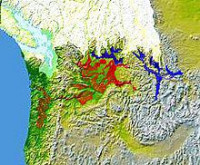|
The hill is composed of loess that was washed away by the Missoula floods. Stop 14 in Baker et al.
"The eastern portions of the Channeled Scabland contain spectacular examples of km-scale hills that show distinctive flow streamlining of their edges (“islands”) and, in some cases, their tops (Fig. 44). These streamlined hills generally occur in local clusters, organized in a braid-like pattern within the overall scabland complex. The hills are composed predominantly of remnant loess that was not stripped from the underlying basalt by the floodwaters. They generally rise up to 50 m above the surrounding scabland areas, and are commonly 1–4 km long and 0.5 km wide. Bretz (1923) first recognized their remarkable shape, with steep, ungullied bounding hillslopes that converge upstream to prow-like terminations and downstream to tapering tails. The drag or resistance to a flowing fluid is minimized for specific relationships among lengths, widths, and areas, which Pleistocene megaflood landscapes of the Channeled Scabland 57 can be quantified for these streamlined landforms (Baker, 1978c, 1979; Komar, 1983, 1984; Baker and Komar, 1987)."

The Missoula Floods (also known as the Spokane Floods or the Bretz Floods) refer to the cataclysmic floods that swept periodically across eastern Washington and down the Columbia River Gorge at the end of the last ice age. The glacial flood events have been researched since the 1920s. These glacial lake outburst floods were the result of periodic sudden ruptures of the ice dam on the Clark Fork River that created Glacial Lake Missoula. After each ice dam rupture, the waters of the lake would rush down the Clark Fork and the Columbia River, flooding much of eastern Washington and the Willamette Valley in western Oregon. After the rupture, the ice would reform, creating Glacial Lake Missoula again.






 Please share your ideas with us.
Please share your ideas with us.